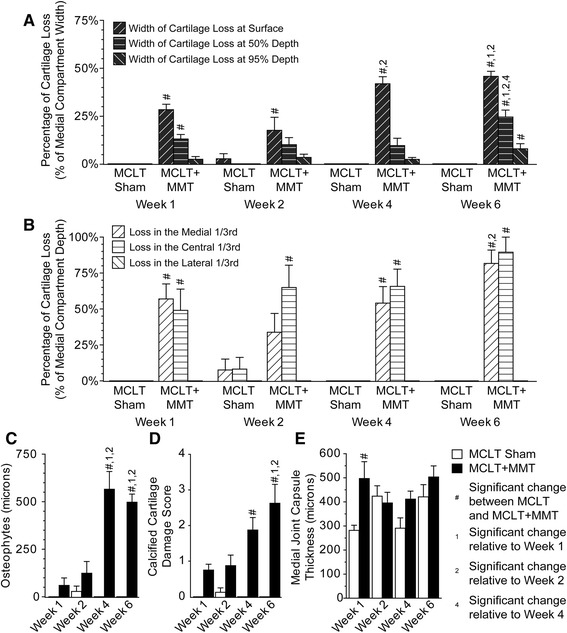Fig. 8.

Cartilage damage and bone remodeling following MCLT and MCLT + MMT surgeries in the rat. Cartilage lesions were identified in the MCLT + MMT groups but not in the MCLT group. a The width of the cartilage lesion was significantly greater in the MCLT + MMT group than in the MCLT group at the cartilage surface at each time point (# p < 0.04), and the width loss at 50 % depth and 95 % depth was wider than in the MCLT group at week 6 (# p < 0.002). Moreover, the percentage of the surface affected increased over time in the MCLT + MMT group (1,2,4 p < 0.008). b The cartilage lesions were located primarily in the central and medial aspects of the medial compartment, with the depth of articular cartilage damage being significantly greater in the MCLT + MMT group than in the MCLT sham group in at least one location at all time points (# p < 0.002). Moreover, the depth of the lesion progressed from nearly 50 % at week 1 to full thickness by week 6. c Significant growth of osteophytes was identified in the MCLT + MMT group at week 4 and week 6 relative to the MCLT control group (# p < 0.001). Moreover, the size of the osteophytes was larger at week 4 and week 6 compared with week 1 and week 1 in the MCLT + MMT group (1,2 p < 0.001). d In addition, significant damage to the calcified cartilage was observed in the MCLT + MMT group relative to the MCLT group at week 4 and week 6 (# p < 0.001), with the damage score in the MCLT + MMT group at week 6 being significantly higher than at week 1 and week 2 (1,2 p < 0.001). Differences in the medial capsule thickness between MCLT sham and MCLT + MMT animals were observed only at week 1 (# p = 0.04, e). Data are presented as mean ± SEM. MCLT medial collateral ligament transection, MMT medial meniscus transection
